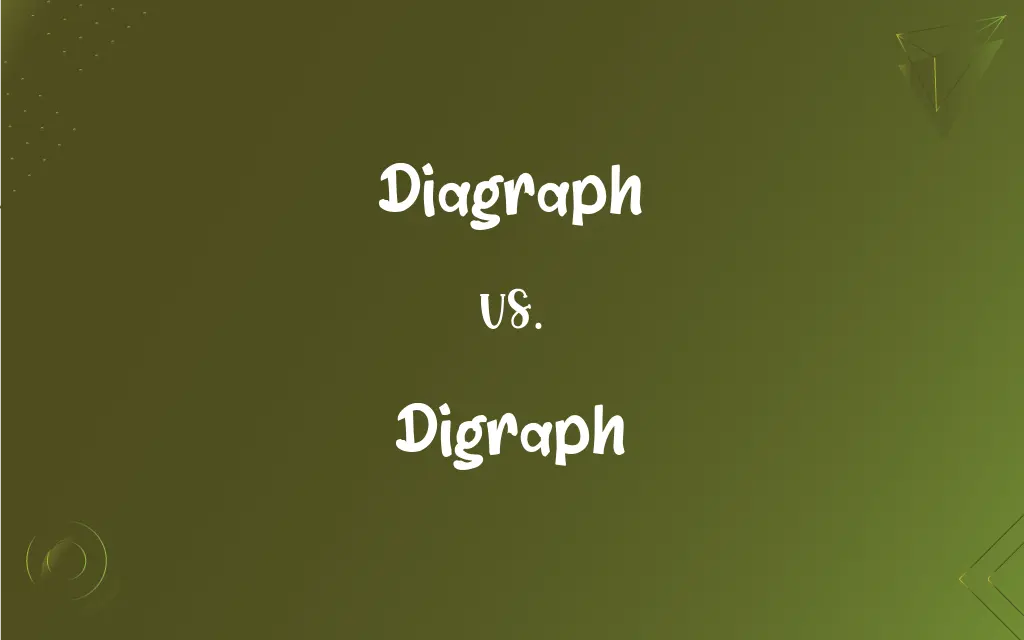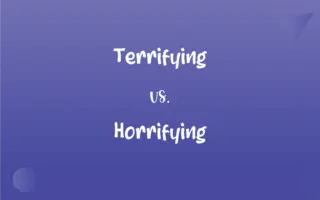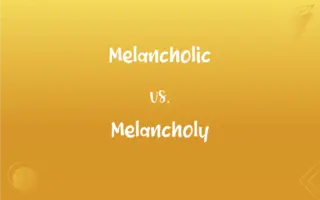Diagraph vs. Digraph: What's the Difference?
By Janet White & Harlon Moss || Updated on March 3, 2024
A digraph is a pair of letters representing a single sound, while "diagraph" is often a misspelling of "digraph."

Key Differences
Digraphs are combinations of two letters that together represent a single phoneme, or sound, in a word. Common examples include "ch" in "cheese," "sh" in "ship," and "th" in "that." These pairs can appear at the beginning, middle, or end of words and are crucial in phonics teaching and learning. On the other hand, "diagraph" is less commonly used and is often considered a misspelling or incorrect variation of "digraph." However, in some rare or specialized contexts, "diagraph" might be used, but its application and definition can vary and are not widely recognized in standard English language usage.
Digraphs are categorized into two main types: vowel digraphs (like "ea" in "bread") and consonant digraphs (like "ch" in "chess"). This distinction helps in teaching and understanding the variety of sounds in English phonetics. Conversely, since "diagraph" is not a standard term, it does not have such categorizations or specific applications in linguistics or phonetics.
Understanding digraphs is essential for literacy, as they are foundational in learning to read and write English effectively. The concept of "diagraph," due to its ambiguity and less frequent use, does not hold the same place in educational or linguistic discussions.
Digraphs are a fundamental concept in understanding English phonetics and literacy, "diagraph" is typically a misspelling and does not carry the same linguistic significance.
Comparison Chart
Definition
Unclear and rarely used
Pair of letters representing one sound; or a directed graph in mathematics
ADVERTISEMENT
Application
Not established
Linguistics and graph theory
Examples
N/A
"ch" in "cheese" or a directed graph with nodes and edges
Significance
Lacks clarity
Essential in understanding phonetics and modeling directional relationships
Contextual Use
Ambiguous
Specific to linguistics and mathematics
Diagraph and Digraph Definitions
Diagraph
It is not commonly found in academic or professional texts.
A search for diagraph in linguistic literature yielded no relevant results.
ADVERTISEMENT
Digraph
A digraph in linguistics is two letters that make one sound.
In English, sh in ship is a digraph representing a single sound.
Diagraph
Its use may cause confusion due to its unclear meaning.
The presentation mentioned diagraphs in a context that suggested directed graphs.
Digraph
Digraphs are crucial for phonetic accuracy in languages.
The digraph th can represent two distinct sounds, as in this and thin.
Diagraph
Diagraph is often a misspelling or misusage, lacking a specific definition.
The term diagraph was used when digraph was intended.
Digraph
Understanding digraphs is fundamental in cryptography and coding.
Digraph frequency analysis is a technique used in breaking ciphers.
Diagraph
When encountered, it's important to clarify the intended meaning.
The instructor asked for clarification upon seeing diagraph in a student's paper.
Digraph
In graph theory, a digraph represents a set of vertices connected by directed edges.
The diagram showed a digraph illustrating the flow of information.
Diagraph
It might be a typographical error or a misunderstanding.
The document contained diagraph likely due to a typing mistake.
Digraph
A pair of letters representing a single speech sound, such as the ph in pheasant or the ea in beat.
Diagraph
(dated) A drawing instrument that combines a protractor and scale.
Digraph
A single character consisting of two letters run together and representing a single sound, such as Old English æ.
Diagraph
A drawing instrument, combining a protractor and scale.
Digraph
(graph theory) A directed graph.
Digraph
(computing) A two-character sequence used to enter a single conceptual character.
Digraph
(linguistics) A pair of letters, especially a pair representing a single phoneme.
Digraph
Two signs or characters combined to express a single articulated sound; as ea in head, or th in bath.
Digraph
Two successive letters (especially two letters used to represent a single sound: `sh' in `shoe')
Digraph
Mathematical digraphs model systems with directionality.
The digraph mapped the predator-prey relationships in the ecosystem.
FAQs
What is a digraph in English?
In English, a digraph is a combination of two letters that represents a single sound, such as "ch" in "church."
What is the purpose of using digraphs in writing?
Digraphs enable the representation of sounds that are not easily represented by single letters, enriching the phonetic and orthographic depth of a language.
Can digraphs consist of vowels as well?
Yes, digraphs can include vowel pairs, like "ea" in "bread," which represent a single vowel sound.
How is a digraph used in graph theory?
In graph theory, a digraph or directed graph consists of nodes connected by edges that have an orientation, representing directional relationships.
How are digraphs taught in language education?
Digraphs are often taught through phonics instruction, emphasizing the sound they represent and providing examples within words.
Is there a difference between consonant and vowel digraphs?
Yes, consonant digraphs involve two consonants that produce a single consonant sound, while vowel digraphs involve two vowels that produce a single vowel sound.
What is the significance of directed graphs in computer science?
Directed graphs are crucial in computer science for modeling data structures, algorithms, and various systems like web navigation and social networks.
Can a single word contain multiple digraphs?
Yes, a word can contain multiple digraphs, each representing a distinct sound within the word.
Are digraphs the same in all languages?
No, digraphs vary across languages, both in the letter combinations used and the sounds they represent.
Can a digraph be at the beginning or end of a word?
Yes, digraphs can appear at the beginning, middle, or end of words, depending on the phonetic structure of the word.
Are there any rules for identifying digraphs in words?
While there are common digraphs, identifying them in words largely depends on understanding the phonetic rules and exceptions in a language.
Do digraphs affect the syllable count in words?
No, digraphs represent a single sound and do not typically affect the syllable count in a word.
How do digraphs impact pronunciation and spelling?
Digraphs play a significant role in pronunciation and spelling, linking the visual representation of words with their phonetic expression.
Can digraphs change over time in a language?
Yes, the use and representation of digraphs can evolve over time as languages change and adapt.
How do digraphs differ from diphthongs?
Digraphs involve two letters producing one sound, whereas diphthongs involve a single vowel sound made by gliding from one vowel sound to another within the same syllable.
How are digraphs handled in text-to-speech systems?
Text-to-speech systems are programmed to recognize digraphs and accurately produce the corresponding sounds for natural-sounding speech.
What role do digraphs play in linguistic research?
Digraphs are important in linguistic research for understanding phonetics, orthography, and the evolution of languages.
Are there any special digraphs used in specific dialects or regional languages?
Certain dialects or regional languages may use unique digraphs that are specific to their phonetic needs and linguistic characteristics.
Are digraphs always consistent in their sound representation?
Digraphs can vary in their sound representation depending on the word and context, highlighting the complexity of language phonetics.
What challenges do digraphs present in language learning?
Digraphs can be challenging for language learners due to their unique sound representation, requiring focused study and practice.
About Author
Written by
Janet WhiteJanet White has been an esteemed writer and blogger for Difference Wiki. Holding a Master's degree in Science and Medical Journalism from the prestigious Boston University, she has consistently demonstrated her expertise and passion for her field. When she's not immersed in her work, Janet relishes her time exercising, delving into a good book, and cherishing moments with friends and family.
Co-written by
Harlon MossHarlon is a seasoned quality moderator and accomplished content writer for Difference Wiki. An alumnus of the prestigious University of California, he earned his degree in Computer Science. Leveraging his academic background, Harlon brings a meticulous and informed perspective to his work, ensuring content accuracy and excellence.
































































